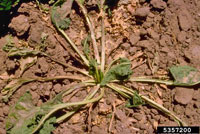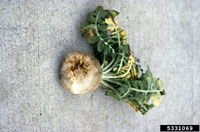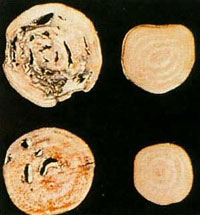Extension > Garden > Diagnose a problem > What's wrong with my plant? > Vegetable > Beet > Distorted leaves
Beet > Leaves > Distorted leaves
1 of 2
Root rot complex
Pythium spp., Rhizoctonia solani, Aphanomyces
cochlioides, and Phoma betae
- Leaves may appear first red colored, then yellow and wilted
- Beet root may be soft and rotten
- Beet roots may develop dark sunken lesions on surface of root
- Fluffy, white to grayish brown fungal growth may be present on rotted areas of the root
- More information on Root Rot Complex
2 of 2
Boron deficiency
- New leaves are elongated and malformed, growing more on one side than the other
- New leaves turn brown and die
- Beet root develops black spots inside, and black dry-rot areas on the root surface
- Dead cross-hatched areas may appear on the inner concave surface of leaf stalks
- More common in alkaline soils
- Symptoms develop mid to late in the season
- More information on Boron Deficiency







